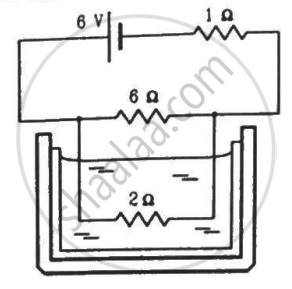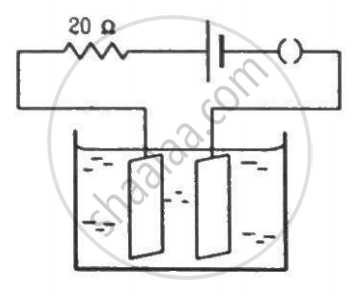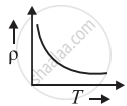Advertisements
Advertisements
Question
The 2.0 Ω resistor shown in the figure is dipped into a calorimeter containing water. The heat capacity of the calorimeter together with water is 2000 J K−1. (a) If the circuit is active for 15 minutes, what would be the rise in the temperature of the water? (b) Suppose the 6.0 Ω resistor gets burnt. What would be the rise in the temperature of the water in the next 15 minutes?

Solution
The effective resistance of the circuit,
\[R_{eff} = \left( \frac{6 \times 2}{6 + 2} \right) + 1 = \frac{5}{2} A\]
Current i through the circuit,
\[i = \frac{V}{R_{eff}} = \frac{6}{5/2} = \frac{12}{5} A\]

Let i' be the current through the 6 Ω resistor. Then,
i' × 6 = (i − i') × 2
\[\Rightarrow 6i' = \left( \frac{12}{5} \right) \times 2 - 2i'\]
\[ \Rightarrow 8i' = \frac{24}{5}\]
\[ \Rightarrow i' = \frac{24}{(5 \times 8)} = \frac{3}{5} A\]
\[ \Rightarrow i - i' = \frac{12}{5} - \frac{3}{5} = \frac{9}{5} A\]
(a) Heat generated in the 2 Ω resistor,
H = (i - i')2Rt
\[\Rightarrow H = \left( \frac{9}{5} \right) \times \left( \frac{9}{5} \right) \times 2 \times 15 \times 60 = 5832 J\]
The heat capacity of the calorimeter together with water is 2000 J K−1. Thus, 2000 J of heat raise the temp by 1 K.
∴ 5832 J of heat raises the temperature by
\[\frac{5832}{2000}=2.916 K\]
(b) When the 6 Ω resistor gets burnt, the effective resistance of the circuit,
Reff = 1 + 2 = 3 Ω
Current through the circuit,
i = \[\frac{6}{3}=2A\]
Heat generated in the 2 Ω resistor = (2)2× 2 × 15 × 60 = 7200 J
2000 J raise the temperature by 1 K.
∴ 7200 J raise the temperature by
\[\frac{7200}{2000}=3.6 K\]
APPEARS IN
RELATED QUESTIONS
A heating element using nichrome connected to a 230 V supply draws an initial current of 3.2 A which settles after a few seconds to a steady value of 2.8 A. What is the steady temperature of the heating element if the room temperature is 27.0°C? The temperature coefficient of resistance of nichrome averaged over the temperature range involved is 1.70 × 10−4 °C−1.
The order of coloured rings in a carbon resistor is red, yellow, blue and silver. The resistance of the
carbon resistor is:
a) 24 x 106 Ω ± 5%
b) 24 x 106 Ω ± 10%
c) 34 x 104 Ω ± 10%
d) 26 x 104 Ω ± 5%
Draw labelled graphs to show how electrical resistance varies with temperature for:
1) a metallic wire.
2) a piece of carbon
Show variation of resistivity of Si with temperature in a graph ?
The thermal energy developed in a current-carrying resistor is given by U = i2 Rt and also by U = Vit. Should we say that U is proportional to i2 or i?
Is work done by a battery always equal to the thermal energy developed in electrical circuit? What happens if a capacitor is connected in the circuit?
Sometimes it is said that "heat is developed" in a resistance when there is an electric current in it. Recall that heat is defined as the energy being transferred due to temperature difference. Is the statement in quotes technically correct?
As the temperature of a metallic resistor is increased, the product of its resistivity and conductivity ____________ .
When a current passes through a resistor, its temperature increases. Is it an adiabatic process?
Is inversion temperature always double the neutral temperature? Does the unit of temperature have an effect in deciding this question?
Is neutral temperature always the arithmetic mean of the inversion temperature and the temperature of the cold junction? Does the unit of temperature have an effect in deciding this question?
The figure shows an electrolyte of AgCl through which a current is passed. It is observed that 2.68 g of silver is deposited in 10 minutes on the cathode. Find the heat developed in the 20 Ω resistor during this period. Atomic weight of silver is 107.9 g/mol−1.

Define temperature coefficient of resistance of the material of a conductor.
By increasing the temperature, the specific resistance of a conductor and a semiconductor -
The higher and lower fixed points on a thermometer are separated by 160 mm. When the length of the mercury thread above the lower point is 40 mm, the temperature reading would be :
The specific resistance of all the metals is the most affected by ______
Temperature dependence of resistivity ρ(T) of semiconductors, insulators and metals is significantly based on the following factors:
- number of charge carriers can change with temperature T.
- time interval between two successive collisions can depend on T.
- length of material can be a function of T.
- mass of carriers is a function of T.
The temperature (T) dependence of resistivity of materials A and material B is represented by fig (i) and fig (ii) respectively. Identify material A and material B.
 fig. (i) |
 fig. (ii) |
